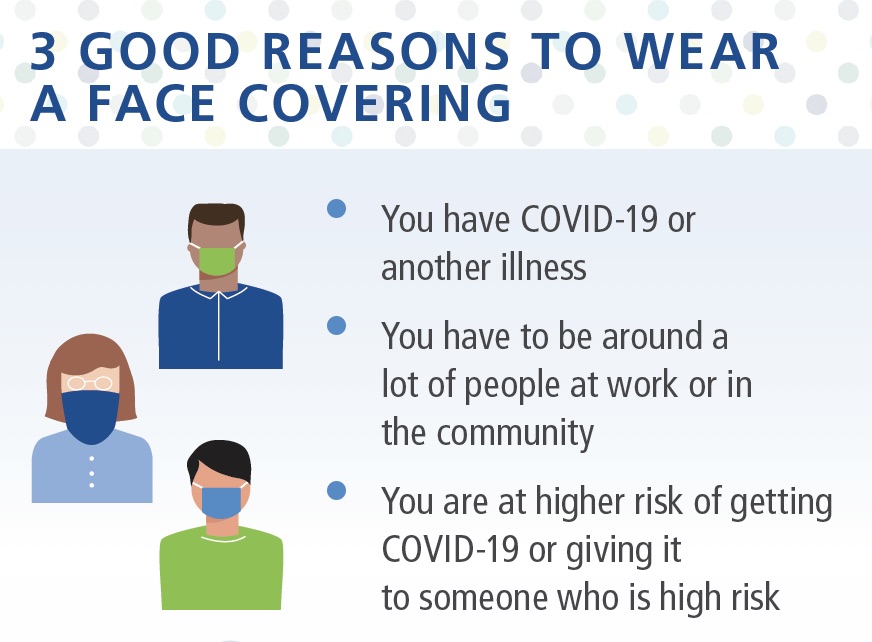Do Your Part: Wear a Face Covering
Do Your Part: Wear a Face Covering
By Unknown
Updated
5 minute read
The use of face coverings in public can reduce the spread of infection in the community by minimizing the release of respiratory droplets from infected people with or without symptoms.
As restrictions begin to loosen and people start to get out more, we have to do our part to stop the spread of COVID-19, which doesn’t look like it’s going anywhere anytime soon. The CDC recommends that everyone wear cloth face coverings in public places where it’s hard to keep a 6-foot distance from other people. Face coverings combined with other preventive measures, such as frequent hand-washing and social distancing, can help slow the spread of the disease.
When to wear a face covering
Wear a face covering when you go out into the public. This includes:
- Shopping at a grocery store or pharmacy
- Going to a restaurant or picking up food from the drive thru or curbside pick up
- While visiting your healthcare provider
- Traveling on public transportation
- Interacting with customers or coworkers
- Visiting a nail salon or hairdresser
The best way to wear a face covering
- Make sure it covers your mouth and nose completely.
- The face covering should fit snugly and comfortably.
- Check to make sure there are no gaps between your face and the cloth face covering.
Different types of masks
There are three main types of masks or face coverings that can help prevent the spread of infection. Here’s a breakdown of each and who they’re best suited for:
- SURGICAL MASK OR MEDICAL MASKS: They shield against the large droplets that come from a sick person’s cough or sneeze; they’re used by healthcare workers.
- RESPIRATOR OR N95 MASKS: They are meant to protect healthcare workers from exposure to infectious particles that may be generated during certain procedures. They must fit just right in order to work.
- CLOTH FACE COVERINGS: They create a barrier for individuals visiting busy, closed spaces such as grocery stores, shopping centers, and healthcare clinics. A cloth face covering is worn to help protect others in case the wearer has the virus. They’re best suited for the general public. Cloth face coverings should not be used on children under age 2 or anyone who has trouble breathing.
Putting on or taking off a face covering
It’s important to learn how to properly put your face covering on and take it off without getting germs on your hands and transferring them somewhere else. Here are some dos and don’ts for safely putting on taking off your face covering:
- DO place your face covering over your mouth and nose.
- DO tie it behind your head or use ear loops and make sure it’s snug.
- DO remove the face covering by untying it or lifting off the ear loops without touching the front of the mask or your face.
- DO wash your hands immediately before AND after removing your face covering.
- DON’T touch your face covering while wearing it. If you accidentally touch your face covering, wash or sanitize your hands.
- DON’T put face coverings on anyone who has trouble breathing or is unconscious or otherwise unable to remove the face covering without help.
- DON’T put face coverings on children under 2 years of age.
- DON’T use face coverings as a substitute for social distancing.
- DON’T wear face coverings under your nose or chin.
How to clean and disinfect a face covering
Cloth face coverings can be laundered in washing machines as long as they're able to retain their shape. Here are two ways you can clean them:
- To wash, knead your face covering for several minutes in hot water using detergent or soap. Rinse well with fresh water and hang to air-dry.
- You can disinfect your face covering by soaking for five minutes in a solution of 2 tablespoons of bleach per quart (liter) of water or 1⁄3 cup (80 mL) of bleach per gallon (3.84 L) of water. Rinse well with fresh water and hang to air-dry.
The use of a face covering, or mask can help reduce the spread of infection in our community. Do YOUR part and wear a face covering when possible.
Where can I get a face covering if I don't have one?
A Mask for Every Utahn is a state of Utah initiative, to help Utahns who may not have a mask and are returning to the workplace or going out in public. The state will provide up to six face coverings per household.
FREE of charge, face coverings will be mailed to requesting Utah residential addresses. This can be done one time when requested.
